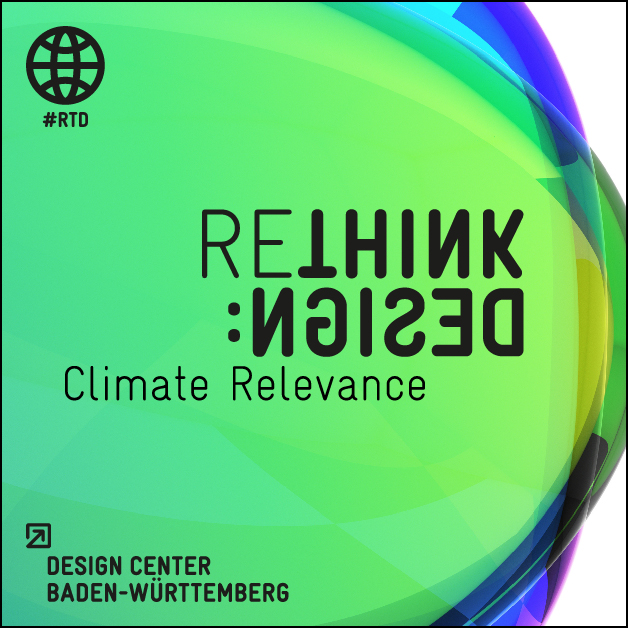

Dear Readers,
According to Germany’s Federal Ministry for the Environment, Nature Conservation, Nuclear Safety and Consumer Protection (BMUV), up to 80% of a product’s environmental impact is predetermined by its design. That’s a huge responsibility, not just for designers – and grounds for us to launch a new format: RETHINK:DESIGN Climate Relevance. From now on, we will be sending special newsletters focusing on climate relevance and design at regular intervals. They will feature positive real-life examples of how design is being rethought in order to meet the challenges of today and – even more importantly – tomorrow.
RETHINK:DESIGN – let’s get started!
According to Germany’s Federal Ministry for the Environment, Nature Conservation, Nuclear Safety and Consumer Protection (BMUV), up to 80% of a product’s environmental impact is predetermined by its design. That’s a huge responsibility, not just for designers – and grounds for us to launch a new format: RETHINK:DESIGN Climate Relevance. From now on, we will be sending special newsletters focusing on climate relevance and design at regular intervals. They will feature positive real-life examples of how design is being rethought in order to meet the challenges of today and – even more importantly – tomorrow.
RETHINK:DESIGN – let’s get started!
How can design help save the climate?

Only considering design in terms of form has always been an inadequate approach. That’s why, ever since its foundation, the Design Center Baden-Württemberg has been shining a spotlight on the economic, conceptual and ecological aspects of product, service and interface design.
Now, the Design Center is focusing special attention on the key issue of sustainability. First and foremost, it’s all about highlighting perspectives that promote the climate-friendly transformation of the economy and society. RETHINK:DESIGN shows what impact design has on resource use, emissions, the circular economy and climate protection.
We’ll be looking at enterprising concepts, shining a light on research, and looking for new mindsets and approaches for accelerating design’s sustainable momentum.
To kick the series off, we paid a visit to Ottenwälder und Ottenwälder in Schwäbisch Gmünd for a fascinating interview that included questions like: Can design agencies be climate-neutral? How much influence do designers have on the aspect of climate relevance? Where will fine-tuning make a difference – not just as far as the client is concerned, but in their own day-to-day business?
But there’s a lot more to RETHINK:DESIGN than this newsletter: in further interviews, talks and workshops, experts will present the complexity of sustainability and climate protection, point out paths to solutions and make the case for a change of perspective – which is exactly what design can do better than any other discipline.
RETHINK:DESIGN – let’s think the future!
“It’s really not that complicated”

An interview with Ottenwälder und Ottenwälder
Can design agencies be climate-neutral? Yes, says Petra Kurz-Ottenwälder of the Ottenwälder und Ottenwälder agency in Schwäbisch Gmünd, which is not just climate-neutral but climate-positive. A conversation about responsibility, the impact of design and systematic carbon accounting.
More and more companies are working on their own climate neutrality. It’s an issue that’s gaining momentum in the design sector too, because it’s not just the use of a product that affects its climate impact: the concept behind it plays a key role as well. In fact, says Germany’s Ministry of the Environment, up to 80% of a product’s effect on the environment is determined during the design phase. In short, design has a responsibility.
Can design agencies be climate-neutral? Yes, says Petra Kurz-Ottenwälder of the Ottenwälder und Ottenwälder agency in Schwäbisch Gmünd, which is not just climate-neutral but climate-positive. A conversation about responsibility, the impact of design and systematic carbon accounting.
More and more companies are working on their own climate neutrality. It’s an issue that’s gaining momentum in the design sector too, because it’s not just the use of a product that affects its climate impact: the concept behind it plays a key role as well. In fact, says Germany’s Ministry of the Environment, up to 80% of a product’s effect on the environment is determined during the design phase. In short, design has a responsibility.
What prompted you to make your agency climate-neutral?
Petra Kurz-Ottenwälder:
We’ve been focusing on the design of long-lasting products for 30 years. For us, sustainable design has always meant that our products don’t age in terms of their appearance, are made of long-lasting materials and are therefore used for a much longer time than fashion-motivated products, which soon start looking outdated. Climate neutrality is a logical continuation of that tradition. In addition, we’ve been running our business with an eye to sustainability for a long time now: we keep distances short, use green electricity, reduce energy consumption and mainly order our materials from regional suppliers. And we’ve only got one company car. We travel by train for the most part anyway.
We’ve been focusing on the design of long-lasting products for 30 years. For us, sustainable design has always meant that our products don’t age in terms of their appearance, are made of long-lasting materials and are therefore used for a much longer time than fashion-motivated products, which soon start looking outdated. Climate neutrality is a logical continuation of that tradition. In addition, we’ve been running our business with an eye to sustainability for a long time now: we keep distances short, use green electricity, reduce energy consumption and mainly order our materials from regional suppliers. And we’ve only got one company car. We travel by train for the most part anyway.
How complex was the road to climate neutrality in your case?
Petra Kurz-Ottenwälder:
To begin with, we weren’t exactly sure where to start […]
Click here to read the full interview
To begin with, we weren’t exactly sure where to start […]
Click here to read the full interview